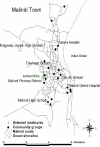Community based vector control in Malindi, Kenya
- PMID: 17604514
- PMCID: PMC1832065
- DOI: 10.5555/afhs.2006.6.4.240
Community based vector control in Malindi, Kenya
Abstract
Background: Community involvement has become an important component of the National Malaria Control Strategy in Kenya, resulting in the organization of groups charged with addressing mosquito and malaria-related concerns within the community.
Objectives: The purpose of this study was to identify community groups involved with intended malaria vector control activity in Malindi, Kenya.
Methods: Information was obtained from key informant interviews, focus group discussions, and a stakeholder meeting. The objectives were to determine the roles of community groups, identify examples of past successes and obstacles to successful implementation of vector control, and assess the level of knowledge about malaria and mosquitoes among the groups.
Results: Nineteen of 34 community groups (56%) registered at social services reported intended malaria vector control activities such as treating ditches, making and selling insecticide-treated mosquito nets, draining stagnant water, organizing clean-ups, making and selling neem soap, and the organization of campaigns such as the "Malaria Mosquito Day". Major challenges facing these groups include volunteerism, lack of technical expertise, supervision, and maintaining control activities in the absence of funds. Most groups reported limited knowledge about malaria vectors, and thus targeted all water bodies for control activities.
Conclusions: We found that community groups are willing to participate in control operations, but lack government and technical support. We highlight the importance of strengthening organizational efforts and capacity building, as well as the need to clarify government policy on malaria vector control responsibilities within the communities.
Figures
References
-
- Keiser J, Utzinger J, Caldas De Castro M, Smith AT, Tanner M, Singer HB. Urbanization in sub-Saharan Africa and implication for malaria control. Am J Trop Med Hyg. 2004;71:118–127. - PubMed
-
- Robert V, Macintyre K, Keating J, et al. Malaria transmission in urban sub-Saharan Africa. Am J Trop Med Hyg. 2003;68:169–176. - PubMed
-
- WHO, author. In Fact Sheet No. 203. Geneva, Switzerland: 1998.
-
- Kitron U, Spielmen A. Suppression of transmission of malaria through source reduction: anti - Anopheline measures applied in Israel, United States, and Italy. Rev Infect Dis. 1989;11:391–406. - PubMed
Publication types
MeSH terms
Grants and funding
LinkOut - more resources
Full Text Sources
Miscellaneous

